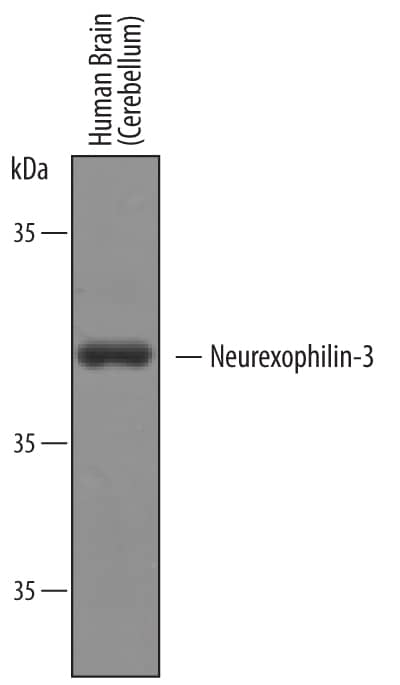Human/Mouse/Rat Neurexophilin-3/NXPH-3 Antibody
R&D Systems, part of Bio-Techne | Catalog # AF5098

Key Product Details
Species Reactivity
Applications
Label
Antibody Source
Product Specifications
Immunogen
Gln23-Gly252
Accession # AAI66603
Specificity
Clonality
Host
Isotype
Scientific Data Images for Human/Mouse/Rat Neurexophilin-3/NXPH-3 Antibody
Detection of Human Neurexophilin‑3/NXPH‑3 by Western Blot.
Western blot shows lysates of human brain (cerebellum) tissue. PVDF membrane was probed with 1 µg/mL of Goat Anti-Human/Mouse/Rat Neurexophilin-3/NXPH-3 Antigen Affinity-purified Polyclonal Antibody (Catalog # AF5098) followed by HRP-conjugated Anti-Goat IgG Secondary Antibody (Catalog # HAF019). A specific band was detected for Neurexophilin-3/NXPH-3 at approximately 45 kDa (as indicated). This experiment was conducted under reducing conditions and using Immunoblot Buffer Group 1.Applications for Human/Mouse/Rat Neurexophilin-3/NXPH-3 Antibody
Western Blot
Sample: Human brain (cerebellum) tissue
Formulation, Preparation, and Storage
Purification
Reconstitution
Formulation
Shipping
Stability & Storage
- 12 months from date of receipt, -20 to -70 °C as supplied.
- 1 month, 2 to 8 °C under sterile conditions after reconstitution.
- 6 months, -20 to -70 °C under sterile conditions after reconstitution.
Background: Neurexophilin-3
Neurexophilin-3 (NXPH-3) is a neuropeptide-like secreted glycoprotein in the neurexophilin family (1, 2). The 252 amino acid (aa) NXPH-3 precursor contains a 22 aa signal peptide, plus a 230 aa proprecursor that is likely cleaved at a basic motif, producing a 76 aa propeptide and a 154 aa mature protein (1). Mature rat NXPH-3 shares 99%, 95% and 92% aa identity with mouse, human and bovine NXPH-3, respectively. It contains motifs that are conserved among all neurexophilins, including three potential N-glycosylation sites in the N-terminal portion and six cysteines in the C-terminal portion (1). NXPH-3 is expressed selectively in subplate-derived neurons in the cortex, granule cells in the vestibulocerebellum, and Cajal-Retzius cells during development (3). NXPH-1 is the neurexophilin most similar to NXPH-3, sharing 69% aa identity within the mature region. Expression of NXPH-1 and NXPH-3 does not appear to overlap, with NXPH-1 expression occurring mainly by cells that resemble inhibitory interneurons (2-4). Both are tightly bound extracellular ligands of alpha-neurexins, synaptic transmembrane molecules that are essential for calcium-triggered neurotransmitter release (1, 5, 6). Genetic deletion of NXPH-1 and/or NXPH-3 produces no anatomical effect, although mice lacking NXPH-3 show specific defects in motor coordination (3, 4). Of the other known neurexophilins, NXPH-2 is not expressed in rodents, and NXPH-4 does not bind alpha-neurexins (1, 5).
References
- Missler, M. and T. C. Sudhof (1998) J. Neurosci. 18:3630.
- Petrenko, A. G. et al. (1996) J. Neurosci. 16:4360.
- Beglopoulos, V. et al. (2005) Mol. Cell. Biol. 25:7278.
- Clarris, H. J. et al. (2002) Int. J. Dev. Biol. 46:649.
- Missler, M. et al. (1998) J. Biol. Chem. 273:34716.
- Dudanova, I. et al. (2006) J. Neurosci. 26:10599.
Alternate Names
Gene Symbol
UniProt
Additional Neurexophilin-3 Products
Product Documents for Human/Mouse/Rat Neurexophilin-3/NXPH-3 Antibody
Product Specific Notices for Human/Mouse/Rat Neurexophilin-3/NXPH-3 Antibody
For research use only
